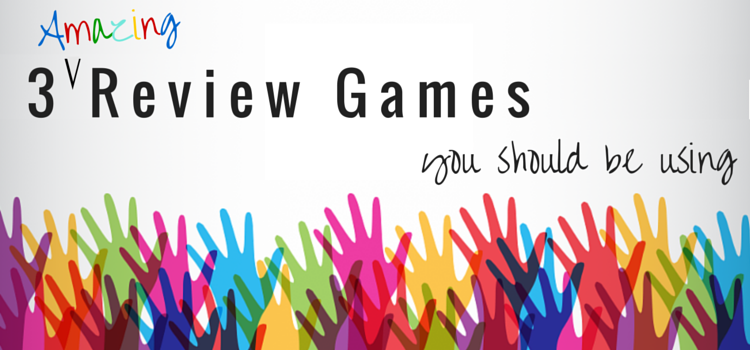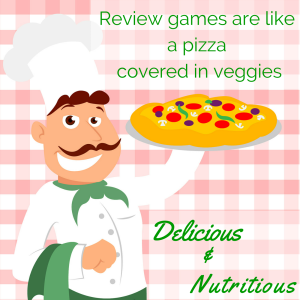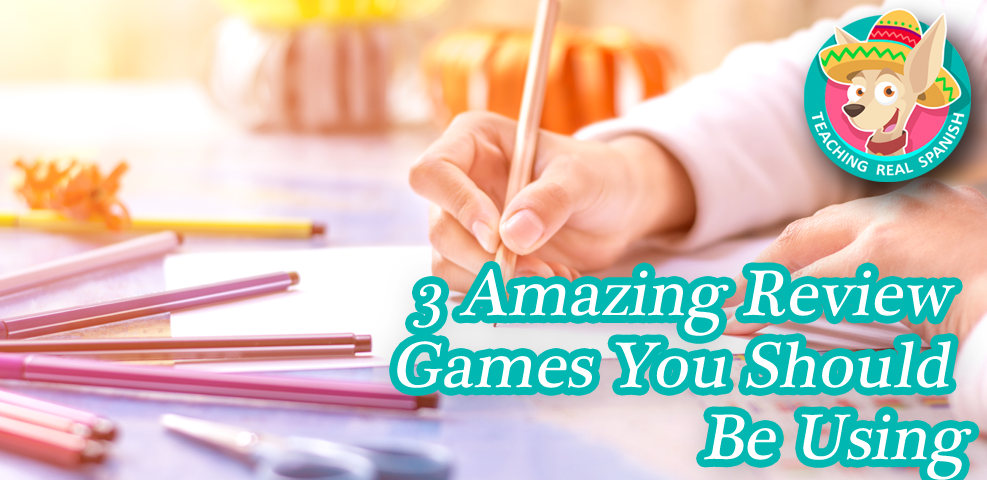 Have you ever tried to get a child to eat vegetables? For most kids it involves some combination of persuasion, bribery, trickery, and nerves of steel.
Have you ever tried to get a child to eat vegetables? For most kids it involves some combination of persuasion, bribery, trickery, and nerves of steel.
As teacher, getting students to 1) know that review is important and 2) actually take action to review information is equally challenging and important.
Review games are our secret weapons. Much like clever moms and dads who sneak broccoli or mushrooms into pizza sauce, teachers sneak learning into games in the classroom.
Fun review games make it easy to review lots of information quickly while engaging students in the class. Additionally, games give students a chance to work together and use different skills than what they’re used to.
Below I’ve taken the time to tell you about 3 review games I use in my classroom. No, the classic Jeopardy review game is not on the list. Jeopardy takes a lot of work to set up whereas these 3 review games are just as fun but not as labor intensive.
I’ve broken each game down into
- A Brief into
- Preparation (before your students arrive)
- Play
- Pros & Cons
1. Grudge Ball
 Grudgeball is not my own original invention, but I absolutely love it! It is one of my go to Spanish review games. I first learned about it here, and I’ve adapted it a little to fit my own needs.
Grudgeball is not my own original invention, but I absolutely love it! It is one of my go to Spanish review games. I first learned about it here, and I’ve adapted it a little to fit my own needs.
Grudgeball seems a little complicated at first for a review game, but if you strip it all down it is basically review basketball. It’s easier to learn as you play, so don’t be afraid to walk through it in your head before you start.
Preparation
- Develop a set of review questions. Probably around 40 to 50 depending on how long your class period is. These can be vocabulary spelling, filling in blanks, giving definitions, creating a sentence, multiple choice, etc. I often use questions similar to those on my exams.
Play:
- Divide your class into teams. You’ll probably want at least 5 to 6 teams.
- On the board, give each team a set of 10 points.
- Ask Team 1 a question. If they answer correctly they don’t earn any points for themselves, they get to take away 2 points from another team. They can take both points from one team or split it. They cannot take points from themselves.
- Before the team takes the points, they have the opportunity to shoot a ball into a basket (or trashcan). If they make it from the 1 point line, they get 1 extra point to take away (if they miss, they lose a take-away point). If they make the basket from the 2 point line, they get two extra points to take-away (or if they miss, they don’t get to take away any points).
- Rinse and repeat for each team.
- Eventually, a team will run out of points. You want to keep those students engaged. SO, when a team has 0 points and they answer a question correctly, they can earn the points back. Once you have points again, you go back to taking points from other teams.
- When you run out of questions or the class ends, the team with the most points wins.
Pros & Cons:
+ You can use questions that are very similar to what students will see on the exam; this helps prepare students for those type of questions
– The game can (as the name implies) bring out some bad qualities in students; I’ve found a simple talk about good sportsmanship at the beginning nearly eliminates this.
2. The Review Gambler
This is another one of my favorites because it gets students to work in teams and it makes themcritically analyze language. I use it mostly for reviewing grammar, but I’m sure you can find ways to adapt it.
Preparation:
- You need to think of a set of 12 sentences. I usually tie them together with a common grammar point or set of vocabulary. Some of them should be grammatically correct, but I prefer most of them to have an error. It is important that they don’t have more than one error.
- Put the sentences onto a worksheet (you can download my template here).
Play:
- Divide students into pairs or small teams and give them each a copy of the worksheet.
- Students have a set amount of time to find and correct the mistakes. If the sentence is error-free mark the “OK” column.
- Tell students they have $1200 to bet. They must bet at least $10 on each sentence and they can’t bet more then $250. Their bet should be based on how much confidence they have that their answer is correct. This goes in the “Stake” column.
- Finally, review the correct answers. If the team bet $20 on a question and correctly identified the mistake, they know have $40. If they didn’t find the mistake, they lose their stake. This goes in the “Result” column.
- Teams add up all of their results and the team with the most money wins!
Pros & Cons:
+ The activity really forces students to analyze the sentences and look critically
+ Promotes self-editing
+ Students work in pairs or small teams which really reduces teacher talk time.
– Pretty limited to grammatical activities (although, if you adapt it let me know!)
3. Mission Impossible
 This is probably my favorite review game to practice lots of simple skills quickly and in a really engaging way. Plus, if you’ve got the energy, you have the chance to pretend to be a secret agent!
This is probably my favorite review game to practice lots of simple skills quickly and in a really engaging way. Plus, if you’ve got the energy, you have the chance to pretend to be a secret agent!
Preparation:
- You’ll need between 5 and 10 different worksheets on different topics. The more students, the more worksheets you’ll need.
- The worksheet needs to be filled with simple activities focus on a single theme, for example, 50 vocabulary words to unscramble or 10 verbs to conjugate or 25 fill-in-the-blank sentences.
- Once you’ve got the worksheets, you need 2 copies: one blank and one with the answers.
- On the back of each worksheet, label them Mission Impossible #1, Mission Impossible #2, Mission Impossible #3, etc etc
Play:
- Put students into pairs. Each pair will receive one Mission Impossible worksheet face down.
- Tell the students they have 1 minute (or 2 depending on how hard/long the worksheets are) to complete the worksheet and they must record their answers on a separate sheet of paper (otherwise you have to make a zillion copies). Don’t give the students too much time or it will seem like work. They have to have a nearly impossible number of questions to finish.
- While the students are working, I play the Mission Impossible theme music and jump around the classroom like a secret agent. It really helps get them into the mood. When the music stops, the students most working.
- At the end of the time, they will check their answers against the answer key (which you can distribute or paste on the wall or something).
- Students record how many questions they answered correctly on each sheet.
- Next, the students pass their worksheet facedown to the next team. All of the worksheets are supposed to move in order so that eventually each team has each worksheet. It helps if you set your students/teams in a circle.
- Start the timer again. Rinse & Repeat.
- The game ends when each student (or pair or team) has had the chance to complete each worksheet. The winner is whoever got the most questions correct over all.
Note: I usually keep track on the board or an excel document the average number of correct responses per sheet so that the students and I know which topics were difficult. This way, I know what to teach more of and they know what to practice.
Pros & Cons:
- + You can easily review a LOT of material quickly
- – It can require a lot of preparation for the worksheets
So this is it my best fun review games for the classroom! I hope you find them useful! Please, let me know in the comments below or via email which review games you use in your classroom!
Happy Teaching!
Marco
Image Credits:
Hands vector used in Header was designed by Freepik
Food vector used in Delicious & Nutritious was designed by Freepik
Basketball vector used in Grudgeball was designed byFreepik

